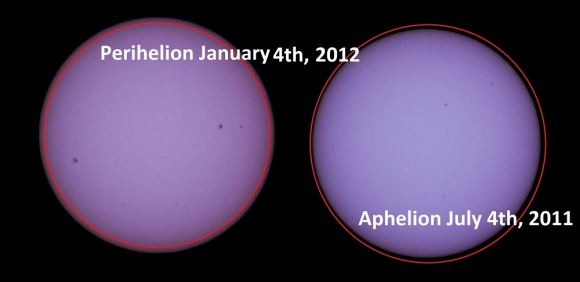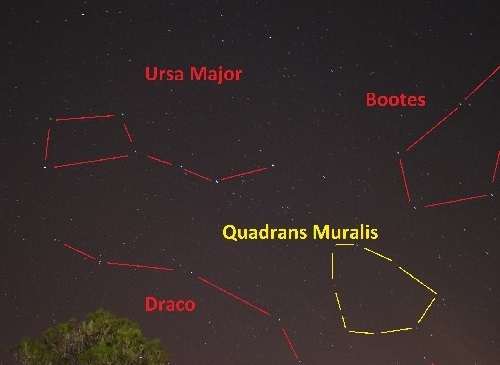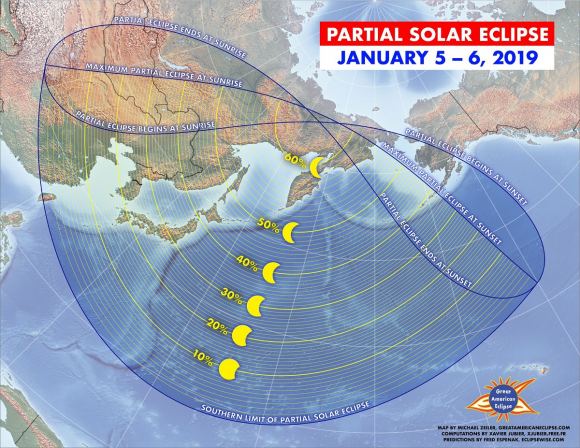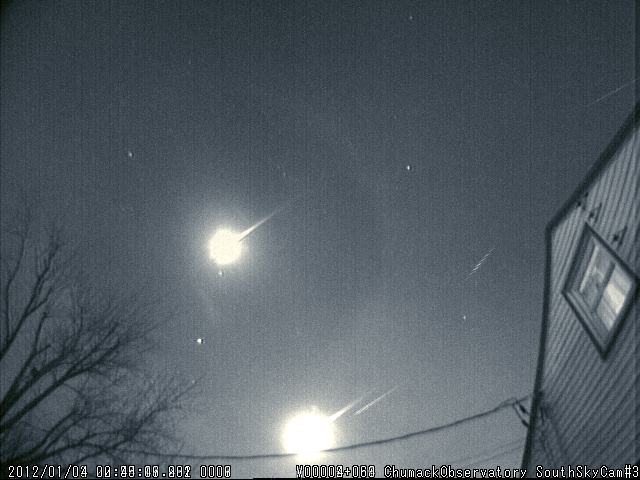Happy New Year! The beginning of the first month of the year is always a busy one for astronomy, and January 2019 is no different, as the Earth reaches perihelion, the Quadrantid meteors peak, and a partial solar eclipse crosses the Pacific… all this week.
Earth at Perihelion
First up, the Earth reaches perihelion on January 3rd at 5:20 Universal Time (UT) January 2nd, 11:20 PM Eastern Standard Time (EST). Though it may not feel it for residents of the chilly northern hemisphere, we’re actually slightly closer to the Sun in early January. In 2019, perihelion reaches 149.8 million kilometers (92.957 million miles) from the Sun, versus aphelion at 152.1 million kilometers (94.5 million miles) on July 4th, 2019. In the 21st century, perihelion can range from 0.9832436 AU (2020) to 0.9833866 AU (2098). Fun fact: the Sun actually appears a smidgen tinier as seen from Earth in January versus July (31′ versus 33′ arcminutes) an effect you can actually photograph.

The date of perihelion and aphelion is also slowly changing, along with the precession of the equinoxes, eccentricity of the Earth’s orbit and the obliquity of the rotational poles in something known as Milankovitch Cycles. In the 21st century, perihelion can occur anywhere from January 2nd to January 5th, largely thanks to the Julian Calendar’s cycle of adding leap days every four years, and aphelion can occur anywhere from July 3rd to 7th.
The Quadrantid Meteors
Next up, the elusive Quadrantid meteors peak on the night of January 3nd into the morning of January 4th, 2019. The “Quads” are often a tough catch; the meteor shower has a sharp but swift six hour peak, often favoring one select longitude, leaving the rest of the world in the dark. In 2019, the peak Zenithal Hourly Rate (ZHR) of 120 meteors per hour is set to occur on January 4th at 2:00 UT, favoring Europe. The Quadrantids favor northern hemisphere observers, and the radiant is located near a point where the constellations of Hercules, Ursa Major and Bootes meet.

The Quadrantids take their name from the now defunct constellation of Quadrans Muralis, the Mural Quadrant. The source of the Quadrantid meteors is the asteroid 2003 EH. 2019 is an especially auspicious year for the Quads, as the Moon is just a 5 percent illuminated, waning crescent at the shower’s peak, offering very little by the way of light pollution. The Quads seem to be a dynamically new shower. You just never know: It’s always worth watching for the Quadrantid meteors around the beginning of the year.
A Pacific-Spanning Partial Solar Eclipse
Finally, this weekend’s New Moon also features the start of the first eclipse season for 2019, with a partial solar eclipse spanning the northern Pacific and the International Date Line on January 5-6th.

New Moon and mid-eclipse occurs on January 6th at 1:30 UT, and Japan, the Koreas and China will get a maximum totality of 1 to 45 percent, south to north. Remote easternmost Russia will get the very best view, at plus 60 percent obscuration. Sparsely populated southwestern Alaska may also get an interesting view if skies are clear of a half-eclipsed Sun at sunset. This eclipse season is also book-ended with a fine total lunar eclipse for North/South America and western Europe on the night of January 21st.
All three astro-events make an amazing trio to kick off 2019.

